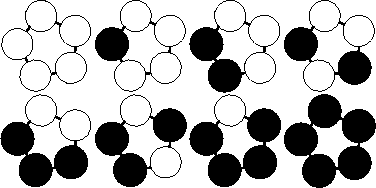POJ 2409 Let it Bead
2013-10-18 21:26
260 查看
[align=center]Let it Bead[/align]
Description
"Let it Bead" company is located upstairs at 700 Cannery Row in Monterey, CA. As you can deduce from the company name, their business is beads. Their PR department found out that customers are interested in buying colored bracelets.
However, over 90 percent of the target audience insists that the bracelets be unique. (Just imagine what happened if two women showed up at the same party wearing identical bracelets!) It's a good thing that bracelets can have different lengths and need not
be made of beads of one color. Help the boss estimating maximum profit by calculating how many different bracelets can be produced.
A bracelet is a ring-like sequence of s beads each of which can have one of c distinct colors. The ring is closed, i.e. has no beginning or end, and has no direction. Assume an unlimited supply of beads of each color. For different values of s and c, calculate
the number of different bracelets that can be made.
Input
Every line of the input file defines a test case and contains two integers: the number of available colors c followed by the length of the bracelets s. Input is terminated by c=s=0. Otherwise, both are positive, and, due to technical
difficulties in the bracelet-fabrication-machine, cs<=32, i.e. their product does not exceed 32.
Output

For each test case output on a single line the number of unique bracelets. The figure below shows the 8 different bracelets that can be made with 2 colors and 5 beads.
Sample Input
Sample Output
Source
Ulm Local 2000
polya 或Burnside引理
| Time Limit: 1000MS | Memory Limit: 65536K | |
| Total Submissions: 4072 | Accepted: 2667 |
"Let it Bead" company is located upstairs at 700 Cannery Row in Monterey, CA. As you can deduce from the company name, their business is beads. Their PR department found out that customers are interested in buying colored bracelets.
However, over 90 percent of the target audience insists that the bracelets be unique. (Just imagine what happened if two women showed up at the same party wearing identical bracelets!) It's a good thing that bracelets can have different lengths and need not
be made of beads of one color. Help the boss estimating maximum profit by calculating how many different bracelets can be produced.
A bracelet is a ring-like sequence of s beads each of which can have one of c distinct colors. The ring is closed, i.e. has no beginning or end, and has no direction. Assume an unlimited supply of beads of each color. For different values of s and c, calculate
the number of different bracelets that can be made.
Input
Every line of the input file defines a test case and contains two integers: the number of available colors c followed by the length of the bracelets s. Input is terminated by c=s=0. Otherwise, both are positive, and, due to technical
difficulties in the bracelet-fabrication-machine, cs<=32, i.e. their product does not exceed 32.
Output

For each test case output on a single line the number of unique bracelets. The figure below shows the 8 different bracelets that can be made with 2 colors and 5 beads.
Sample Input
1 1 2 1 2 2 5 1 2 5 2 6 6 2 0 0
Sample Output
1 2 3 5 8 13 21
Source
Ulm Local 2000
polya 或Burnside引理
#include <iostream>
#include <cstring>
#include <cstdio>
#include <cmath>
#define N 40
using namespace std;
__int64 a
;
int main()
{
//freopen("data.in","r",stdin);
int gcd(int x,int y);
int n,m;
while(scanf("%d %d",&m,&n)!=EOF)
{
if(n==0&&m==0)
{
break;
}
if(n==0)
{
printf("0\n");
continue;
}
a[1] = m;
for(int i=2;i<=n;i++)
{
a[i]=a[i-1]*m;
}
__int64 res1=0;
for(int i=1;i<=n;i++)
{
res1+=(a[gcd(i,n)]);
}
__int64 res2=0;
if(n%2)
{
res2 +=(n*a[(n+1)/2]);
}else
{
res2+=((n/2)*(a[(n/2)+1]+a[n/2]));
}
cout<<(res1+res2)/2/n<<endl;
}
return 0;
}
int gcd(int x,int y)
{
return y==0 ? x:gcd(y,x%y);
}
相关文章推荐
- poj2409 Let it Bead(polyal原理)
- poj 2409 【Let it Bead】
- POJ 2409 Let it Bead(polya染色问题)
- POJ 2409 Let it Bead (Polya)
- poj 1286 Necklace of Beads & poj 2409 Let it Bead(初涉polya定理)
- poj 2409 Let it Bead
- POJ 2409 Let it Bead
- poj 2409 Let it Bead【polya定理+burnside引理】
- poj 2409、1286 Let it Bead
- POJ - 2409 - Let it Bead - (Polya定理)
- POJ 2409 Let it Bead
- POJ 2409 Let it Bead (Polya计数)
- POJ 2409 Let it Bead (Polya计数)
- Let it Bead (POJ - 2409) (polya计数原理)
- 置换群Polya定理(poj 2409: Let it Bead)
- poj 2409 Let it Bead(polya定理)
- POJ 2409 Let it Bead
- poj 2409 Let it Bead
- POJ 2409 Let it Bead polya 定理 和 置换
- POJ 2409 let_it_bead
